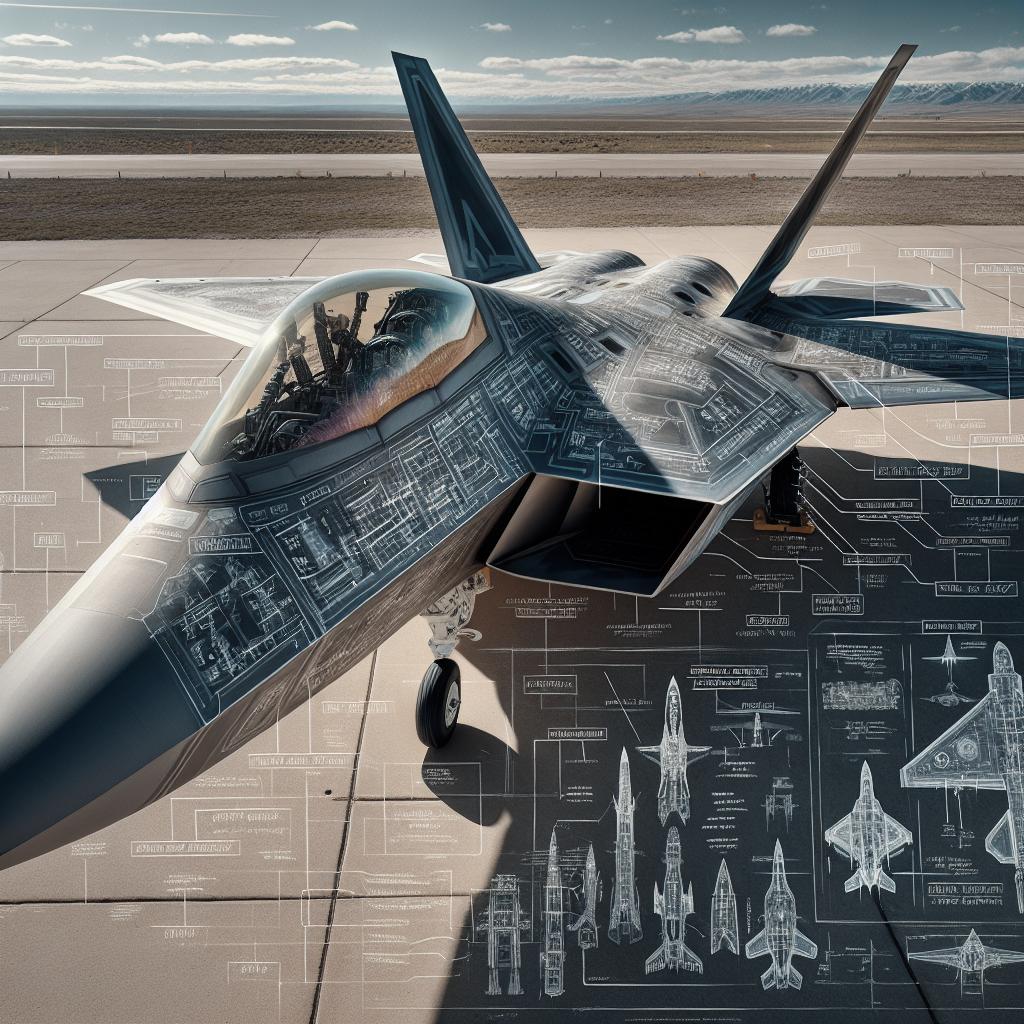“`html
The F-22 Raptor is one of the most advanced fighter jets in the world. Developed by Lockheed Martin and first flown in 1997, this stealth aircraft is renowned for its unparalleled capabilities in air dominance and precision attack operations. This blog post will delve into various aspects of the F-22, including its development, deployment, unique design, cockpit features, weaponry, radar systems, countermeasures, navigation, and engine specifications. We aim to provide an exhaustive guide for anyone interested in the detailed specifications of this groundbreaking aircraft.
F-22A Raptor development
The F-22A Raptor was conceptualized during a critical period when the United States recognized the need for an air dominance fighter to replace the aging F-15 Eagle. In 1986, the US Air Force initiated the Advanced Tactical Fighter (ATF) program which led to the competition between Lockheed Martin’s YF-22 and Northrop’s YF-23. Ultimately, the YF-22 was chosen in 1991, and the aircraft went into full-scale development shortly thereafter.
The development process was marked by numerous technological advancements, which set new benchmarks in stealth capabilities, avionics, and aerodynamics. A combination of extensive computer simulations and wind tunnel tests were employed, leading to the successful maiden flight of the prototype in 1997. The aircraft officially entered service in 2005, transforming US air combat capabilities.
F-22A Raptor deployment and bases
The F-22A Raptor is primarily deployed within the United States, where it serves in several key Air Force bases. Some of the prominent bases include Langley Air Force Base in Virginia, Elmendorf Air Force Base in Alaska, and Nellis Air Force Base in Nevada. These bases serve as strategic locations, affording the US quick response capabilities in various global theaters.
In addition to domestic deployment, the F-22 has also been involved in several international exercises and operations. Notably, the aircraft has taken part in missions in the Middle East, where it has served as a powerful deterrent and actionable asset in maintaining air superiority.
F-22 Raptor design and features
The F-22 Raptor boasts an impressive design that emphasizes stealth, speed, agility, and situational awareness. Its airframe is made from advanced composite materials, which reduce radar cross-section and enhance durability. The aircraft’s sleek, angular design minimizes radar signatures, making it virtually invisible to enemy radar systems.
One of the Raptor’s standout features is its thrust vectoring capability, provided by its two-dimensional thrust vectoring nozzles. This allows for unparalleled maneuverability, especially in dogfights. The aircraft’s avionics and sensor systems, including the AN/APG-77 radar, provide comprehensive situational awareness, ensuring the pilot has an edge in both offensive and defensive scenarios.
F-22 cockpit
The F-22 cockpit is an epitome of modern aviation technology, designed to enhance pilot effectiveness and reduce workload. The glass cockpit features multifunctional displays and advanced controls that provide real-time data and an intuitive interface for mission management. The Helmet Mounted Display (HMD) system allows pilots to receive crucial information without having to look down at instruments.
Ergonomics are another major focus in the F-22’s cockpit design. With a side-stick controller and throttle systems, pilots find it easier to control the aircraft during complex maneuvers. The advanced ejection seat also ensures the safety of the pilot in extreme situations, adding another layer of assurance during high-risk combat scenarios.
F-22 weapons
The F-22 Raptor is armed with a variety of weapons designed to engage multiple types of targets, ranging from enemy aircraft to ground installations. It is equipped with an M61A2 Vulcan six-barrel rotary cannon for close-in dogfighting scenarios. Additionally, the aircraft can carry a combination of AIM-120 AMRAAM and AIM-9 Sidewinder missiles for long-range and short-range air combat.
For ground attack missions, the F-22 can be configured to carry precision-guided munitions such as the GBU-32 JDAM (Joint Direct Attack Munition). These capabilities allow the Raptor to perform a wide range of missions, making it a versatile tool in the USAF’s arsenal.
Radar
The F-22 Raptor’s radar system, the AN/APG-77, is one of its most advanced features. This Active Electronically Scanned Array (AESA) radar provides significant advantages in terms of range, speed, and detection capabilities. It can simultaneously track multiple targets in the air and on the ground, providing unparalleled situational awareness.
One noteworthy feature of the AN/APG-77 is its Low Probability of Intercept (LPI) capability. This allows the radar to operate without being detected by enemy electronic warfare systems, giving the F-22 a significant tactical advantage. The radar also supports high-resolution mapping, making it effective in all types of combat scenarios.
Countermeasures of F-22 Raptor
The F-22 is equipped with a comprehensive suite of countermeasures designed to foil enemy attacks. These include advanced electronic warfare systems that can jam enemy radars and communications. The aircraft also features a radar absorbent material (RAM) coating, which decreases its radar signature, making it difficult for enemy systems to lock on.
Additionally, the F-22 is equipped with flares and chaff to evade infrared and radar-guided missiles. These countermeasures, combined with its stealth capabilities, render the Raptor an incredibly difficult target to detect, track, and engage successfully.
Navigation and communications
The F-22 features an advanced Inertial Navigation System (INS) paired with GPS for precise navigation. This combination ensures the Raptor can operate effectively in both jammed and GPS-denied environments. The aircraft also features sophisticated communication systems that enable secure data link connections with other platforms, enhancing cooperative engagements.
Its data fusion capabilities are among the best in the world, integrating inputs from various sensors to provide a coherent operational picture. This situational awareness ensures that the pilot can make informed decisions quickly, significantly increasing mission success rates.
F-22 engine
Lockheed Martin F-22 Raptor
The F-22 Raptor is powered by two Pratt & Whitney F119-PW-100 turbofan engines. These engines are designed to provide superior thrust and fuel efficiency, which enables the aircraft to achieve and sustain supersonic speeds without the need for afterburners—a capability known as supercruise. The engines also feature 2D thrust vectoring nozzles, giving the Raptor unmatched agility.
The advanced design of these engines also ensures reduced maintenance requirements and increased operational lifespan. The combination of power, efficiency, and maneuverability provided by the F119 engines places the F-22 Raptor at the top of any air superiority role.
Recommended White Papers
For those looking to dive deeper into the technological aspects and development of the F-22 Raptor, numerous white papers from defense and aerospace research institutions offer detailed analyses. Topics range from stealth technology breakthroughs to advancements in radar and avionics systems. These documents are invaluable resources for professionals and enthusiasts alike.
Recommended Buyers Guides
If you are considering purchasing fighter aircraft or upgrading your current fleet, several reputable buyers guides offer comprehensive reviews and comparisons of available options. These guides take into account performance, cost, and operational effectiveness to help you make an informed decision. While the F-22 Raptor may not be openly available for purchase due to its classified nature, understanding its specifications can inform your choices on similar, available models.
Future prospects
| Specification Aspect | Details |
|---|---|
| Development | Initiated under the Advanced Tactical Fighter (ATF) program, chosen in 1991, first flown in 1997, entered service in 2005 |
| Deployment and Bases | Primarily stationed in the US, involved in international missions |
| Design and Features | Stealth, advanced composites, thrust vectoring, AN/APG-77 radar |
| Cockpit | Glass cockpit, multifunctional displays, HMD, ergonomic design |
| Weapons | M61A2 Vulcan, AIM-120 AMRAAM, AIM-9 Sidewinder, GBU-32 JDAM |
| Radar | AN/APG-77 AESA radar, LPI capability, high-resolution mapping |
| Countermeasures | Advanced electronic warfare systems, RAM coating, flares, and chaff |
| Navigation and Communications | INS paired with GPS, secure data link connections, data fusion capabilities |
| Engine | Two Pratt & Whitney F119-PW-100 turbofan engines, supercruise, 2D thrust vectoring |
“`


